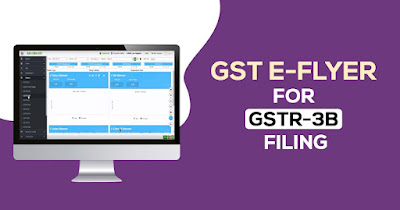The GST return filing process (FORM GSTR-3B) E-Flyer has been released by the SAG Infotech Private L:imited.
Process of return filing
Filing Form GSTR-3B – Monthly and Quarterly Return by Normal Taxpayer
What is the method to make, save, pay taxes, and file the Form GSTR-3B return?
Form GSTR-3B is said to be the easier summary return, its objective is for the assessees to show their GST obligation summary for a certain tax duration and the discharge of these liabilities. A normal assessee is needed to file the FORM GSTR-3B returns for every tax period.
Login and Navigate to Form GSTR-3B Monthly Return page:
1. Access the www.gst.gov.in URL. The GST Home page is shown. Login to the GST Portal with valid credentials.
2. Tap on the Services > Returns > Returns Dashboard option.
3. The file returns page is shown. Choose the Financial year, Quarter (Quarter 1 – 4), and period (month) for which you wish to file the return from the drop-down list. Tap on the SEARCH button.
4. The file returns page is shown. The same page shows the last date for filing the returns, which the assessees are obligated to file (through separate tiles). In the Form GSTR-3B tile, tap the prepare online button.
5. A list of questions has been shown. You are required to answer all the questions to display the related sections of FORM GSTR 3B as applied before you. Tap on the NEXT button. On the basis of your answers related tables of FORM GSTR-3B shall be seen on the next screen. You might proceed back to the previous screen by tapping the BACK button.
Note: For the case of auto-population from form GSTR-1 or form GSTR-2B, merely the first question will be shown on the page of the questionnaire.
To file a Non-Nil return: The System Generated Summary for GSTR-3B is depicted. The same page shows the GSTR-3B table, Source Form, Form Status, Summary Status, and advisory information. Tap on to CLOSE button to view form GSTR-3B – Monthly Return page.
The form GSTR-3B – Monthly Return page is shown. Tap the system-generated GSTR-3B button to download and view system-calculated information from FORMS GSTR-1 and GSTR-2B (monthly or quarterly) in FORM GSTR-3B.
Note- Applicable tiles will be displayed to you for furnishing the information based on the selection made on the previous page.
Note- You can tap the system-generated GSTR-3B to view system-calculated information from forms GSTR-1 & GSTR-2B form.
The values that are auto-populated in System Generated GSTR-3B are for the support of the assessee. However, the assessee needed to ensure the correctness of the values being reported and filed in GSTR-3B in all regards.
Taxpayers have the option to modify auto-populated values as needed. They can proceed with their filing using these edited values without any restrictions from the system.
Multiple tiles will display various Tables for entering pertinent information. Tap on the tile names to give the requisite information, for the pertinent tax period:
a. Tax on outward and reverse charge inward supplies: To furnish the information of summary of outward supplies and inward supplies liable to reverse charge and tax obligation thereon.
b. Inter-state supplies: For giving the information about the inter-state supplies incurred to the unregistered individuals, composition taxable individuals and UIN holders, and tax thereon.
c. Eligible ITC: For furnishing the summary information of the eligible ITC claimed, ITC reversals, and the Ineligible ITC.
d. Exempt, nil, and non-GST inward supplies: To allocate the information for the summary of exempt, nil, and non-GST inward supplies.
e. Interest and Late Fee: To furnish summary particulars of Interest and Late fee liable to get paid.
f. Tax Payment: To furnish particulars of payment of taxes, interest, and late fees.


Comments
Post a Comment